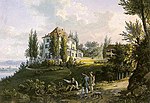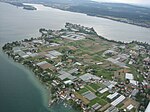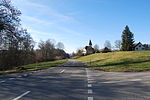Reichenau Island (German: [ˈʁaɪçənaʊ]) is an island in Lake Constance in Southern Germany. It lies almost due west of the city of Konstanz, between the Gnadensee and the Untersee, two parts of Lake Constance. With a total land surface of 4.3 km2 (1.7 sq mi) and a circumference of 11 km (6.8 mi), the island is 4.5 km (2.8 mi) long and 1.5 km (0.93 mi) wide at its greatest extent. The highest point, the Hochwart, stands some 43 m (141 ft) above the lake surface and 438.7 m (1,439 ft) above mean sea level.
Reichenau is connected to the mainland by a causeway, completed in 1838, which is intersected between the ruins of Schopflen Castle and the eastern end of Reichenau Island by a 10-metre-wide (33 ft) and 95-metre-long (312 ft) waterway, the Bruckgraben. A low road bridge allows the passage of ordinary boats but not of sailing-boats.
In 724, the first monastery was built on the island by bishop Pirmin, and Reichenau quickly developed into an influential religious, cultural, and intellectual center. During the Early and High Middle Ages, the Reichenau Abbey was one of the significant monasteries across the Frankish Empire. Because of its historical importance and the exceptional quality of the architecture and artwork found in the island's three churches and abbey, Reichenau was declared a World Heritage Site in 2000.











